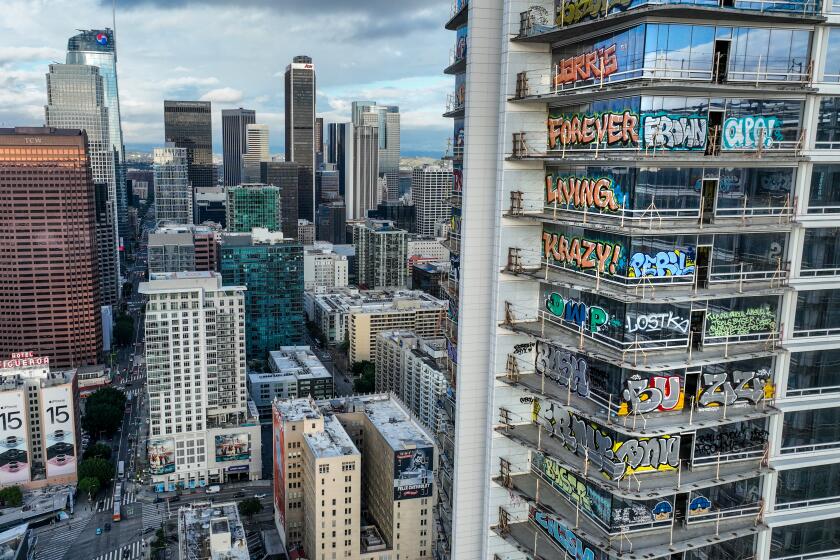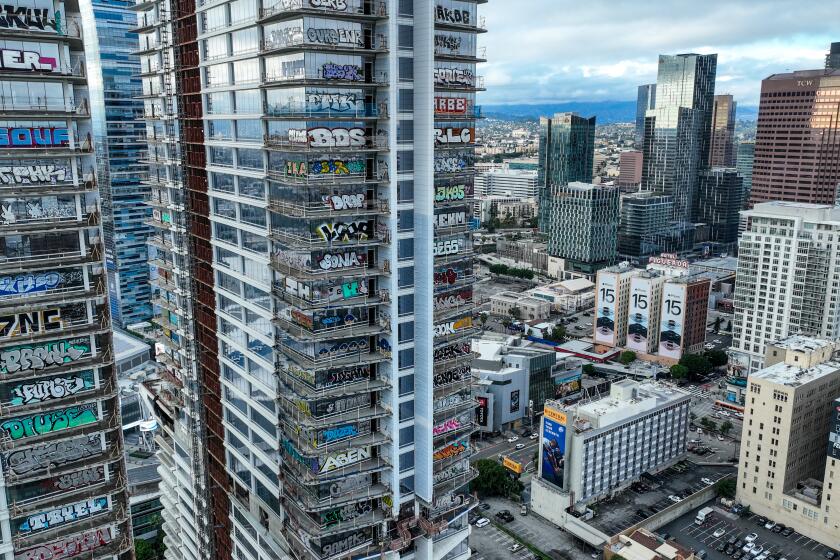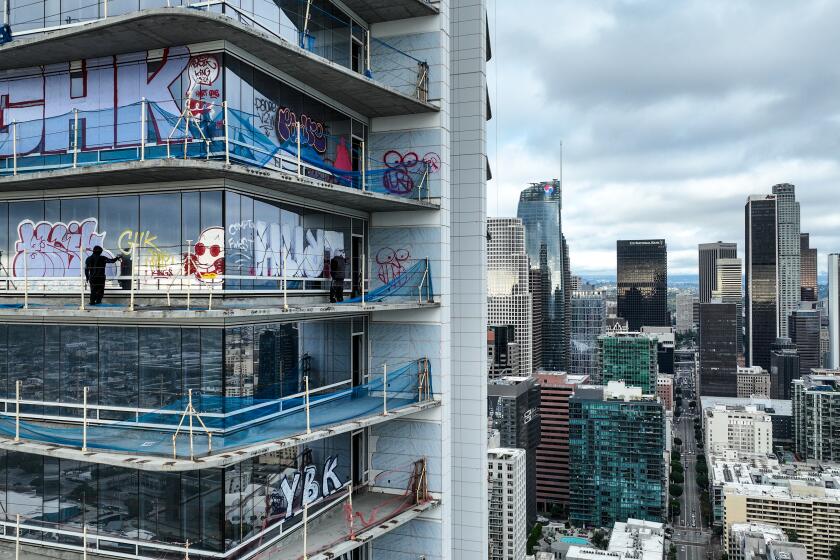Graffiti tower debate shows Los Angeles’ contradictory relationship with street culture

Los Angeles has always had a contradictory relationship with graffiti and the street cultures that birthed it.
The city spends more than $11 million painting over graffiti each year, according to the Office of Community Beautification. Last year alone, the city paid to cover more than 32 million square feet of graffiti, said Paul Racs, the office’s director.
Last year was also the year city leaders presented the family of Chris “Spanto” Printup, the late streetwear star and former graffiti writer, with a framed proclamation for his contributions to city culture. It was a formal recognition that graffiti artists are central to Los Angeles’ identity, but I couldn’t help but wonder about the gesture’s sincerity. After all, this is the same City council that gave speeches at Nipsey Hussle’s funeral, vowed to “defund the police” after George Floyd died, then voted in 2023 to increase police salaries by $400 million.
After several arrests related to a vandalized L.A. skyscraper project, the City Council voted to spend $3.8 million to clean up and secure the site.
It wasn’t so surprising that it took this council less than two weeks to approve $3.8 million to fence off and clean an abandoned downtown luxury residential development that in February become a canvas for the city’s graffiti artists. A complicated debate has followed with few easy answers. Is graffiti art or vandalism? Is graffiti harmful, and is an abandoned property made worse by graffiti? And what does graffiti say about the state of Los Angeles overall?
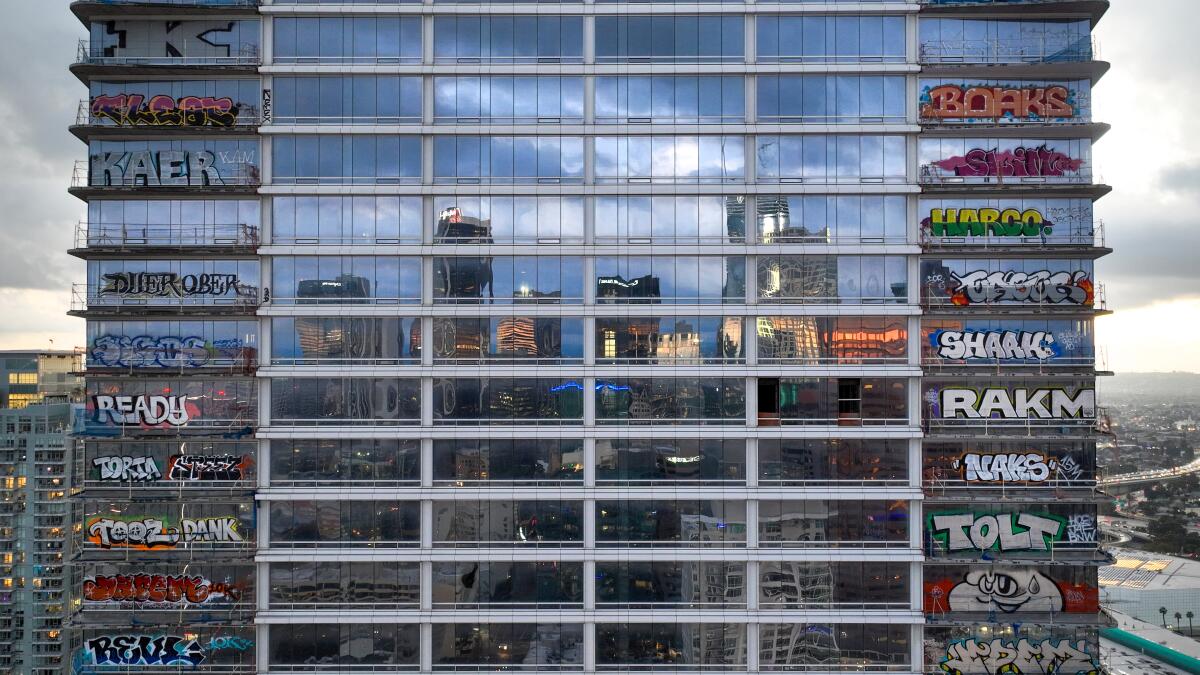
More than a month later, the tower is surrounded by fences and Los Angeles Police Department cruisers, but the graffiti is still there. A few taco trucks have clustered nearby to capture lunch crowds from the Los Angeles Convention Center, and some of the truck operators report increased foot traffic after the tower was tagged. It’s become a popular social media attraction, and on a recent weekday I ran into a photographer and a clothing designer on a photo shoot a few seconds after parking my car. They were unambiguously in favor of the graffiti.
“It shows the city’s character more than an empty building,” said photographer Maidar Manlai, 24.
The harms of graffiti are most often seen with small mom and pop enterprises navigating high-crime neighborhoods, losing foot traffic after having their businesses vandalized. But in downtown Los Angeles, the graffiti tower’s neighbors are the Crypto.com Arena, luxury housing developments, and boutique law firms and hotels — well-capitalized businesses that do not depend on foot traffic.
And on the other side of downtown, graffiti-inspired murals abound in the Arts District. Street art is used to promote restaurants, brand high-end retail shops and fill galleries and museums.
The colorful graffiti that adorns an abandoned skyscraper in downtown L.A. is, depending on who you ask, petty vandalism that plagues the city or vibrant street art that enriches.
Racs acknowledges that graffifti is cultural expression, and he can even admit that in some neighborhoods it has a positive effect on real estate prices. But after 30 years of working on the issue, he says the debate between vandalism and art is simple: If there’s no permission, then it’s a crime. Graffiti that’s left up only creates more graffiti, which might lead to more crime, Racs said.
“You’re inflicting a cost on someone else. Someone has to pay for cleaning it up,” Racs said.
Manuel Estevez, a manager at a cigar lounge a block away from the graffiti tower, echoes Racs’ concerns. He believes in police reform, grew up around graffiti and doesn’t believe in criminalizing it further. But he wondered whether graffiti could hurt not just foot traffic, but also local investment. His business pays a premium to rent downtown real estate under the assumption that there will be wealthy customers. What if international tourists are turned off and reduce their trips to Los Angeles? Does graffiti turn off potential residents and make investors less likely to buy in?
“I’m not against graffiti art,” Estevez said. “It just depends on where.”
It’s impossible to draw a clean line between art and vandalism when it comes to graffiti, said Susan A. Phillips, a professor of environmental analysis at Pitzer College and author of “The City Beneath: A Century of Los Angeles Graffiti.” Focusing on that question blinds you to the real reasons graffiti exists, she said.
“It’s really an anti-capitalism critique. It questions corporate control over public space. It upends our concept of private property and draws attention to the increasing privatization of public space in the city,” Phillips said.
I can think of no place in Los Angeles that needs that critique more than downtown Los Angeles, where some of the most valuable property in the city has been concentrated in the hands of a wealthy few. And Oceanwide Plaza is far from the only stalled mega-development in downtown Los Angeles.
I don’t think many graffiti artists would try to defend their actions as noble activism. Most I’ve spoken to are surprisingly honest about the egos and urges that motivate them. But there’s an obvious critique in graffiti’s persistent presence in impoverished communities. To me, it’s not hard to understand why generations of young people, deprived of the ability to exert ownership over their own neighborhoods, take up spray paint cans and write their names as big as they can.
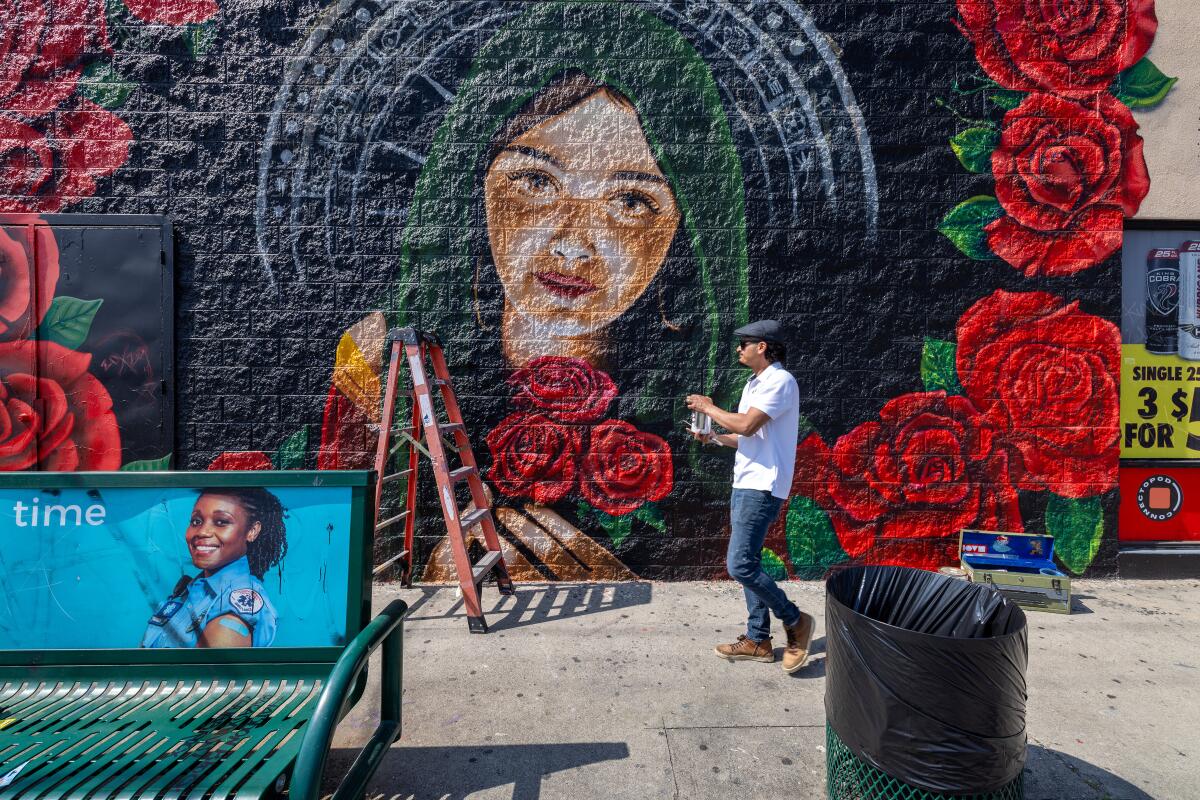
Graffiti can be a force for good, said Levi Ponce, 36, a muralist who began as a sign painter and graffiti artist. I met Ponce 12 years ago when he was helping to create Pacoima’s Mural Mile, an effort to beautify his hometown and attract more visitors to the area. When he sees skillful graffiti, he sees untapped potential.
“All people see is the graffiti, but the root of the situation is that there are all of these people that are left without a platform, that feel invisible,” said Ponce, who has painted murals off the 110 Freeway and at Sofi Stadium. “A wall tag is saying, ‘I am here. I can contribute. I have talent.’”
Two people were arrested in connection with spray painting about 27 floors of an unfinished skyscraper in downtown Los Angeles, authorities said.
Ponce enlists graffiti artists as volunteers, a strategy that turns potential rivals into stakeholders, he said. Many graffiti artists would love to earn a living from their work. He suggests creating designated graffiti areas and working with artists, instead of just arresting them.
“The same guys that were out vandalizing this mural are now out at night protecting it,” he said. “The act of painting is not the problem. We need to ask, ‘Why are they out here alone at night, scouting for walls, putting themselves in danger just to do art?’”
Los Angeles has one of the most progressive public art programs in the country. Murals registered with the city are listed in an online database and receive a coat of protective paint free of charge.
But permitted and commercialized art has its own problems, and you just have to look next door to the graffiti tower to find them.
Across the street, the Clippers commissioned a giant mural of the basketball team’s small forward Kawhi Leonard, which heavily features the sprayed lines and edgy fonts that form graffiti’s visual language. The credited artist is Thierry Guetta, also known as Mr. Brainwash, whose entire rise to art world prominence was famously contrived by the street artist Banksy in the documentary “Exit Through the Gift Shop.”
The documentary — and Guetta’s fame — was intended as a biting commentary on the ignorant, overeager commercialization of street art. But ironically, Mr. Brainwash’s art career thrived after the credits rolled.
Many highly regarded, influential graffiti artists still struggle with poverty, addiction and criminal records. Most have never seen a dollar for their work. But artists like Mr. Brainwash have profited generously from street art.
His work, which features blandly positive phrases like “Life is beautiful” and “Time will tell,” appears in TV shows such as “Billions” and “Shameless.” He has partnered with Coca-Cola and Marvel, and in 2022, he opened his own museum in Beverly Hills.
More to Read
Sign up for Essential California
The most important California stories and recommendations in your inbox every morning.
You may occasionally receive promotional content from the Los Angeles Times.
